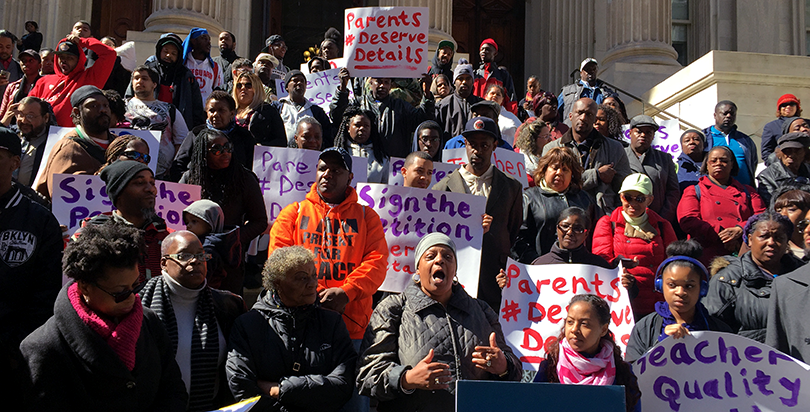NYC Refuses to Provide Information About $100 Million ‘Absent Teacher Reserve,’ Advocates Claim

Updated 4:30 p.m.
(New York City) — Advocates and parents with the education reform group StudentsFirstNY are demanding that New York City release records of the roughly 1,100 public school teachers who are on its payroll indefinitely but don’t have a job to do.
The teachers are part of what’s known as the Absent Teacher Reserve, which costs taxpayers an estimated $100 million per year. Teachers end up in the reserve if their jobs have been eliminated due to a school closure or downsizing, or they may be placed there during misconduct hearings.
Regardless of the reason, teachers in the ATR receive full salaries and benefits while they wait to be assigned to a classroom or for disciplinary proceedings to proceed, sometimes languishing for months or years at a time.
StudentsFirstNY has sharply criticized Mayor Bill de Blasio’s education policies, including the city’s plan to shrink the size of the pool by returning teachers back to classrooms under the terms of the 2014 teachers contract.
More than 70 parents and StudentsFirstNY members rallied in front of the Department of Education headquarters in lower Manhattan Wednesday morning, urging the administration to publicize the details of ATR teacher placements.

Parents said public knowledge of where poorly rated teachers — or those who’ve faced misconduct charges — are working when they’re returned to the classroom from the reserve is a matter of educational equity.
“We deserve to know the details on the city’s ATR pool and we deserve to know them now,” Queens parent Crystal Lee-McJunkin told the crowd, standing on the steps of the Tweed Courthouse. “As a parent, there’s a lack of transparency and I’m sick of it.”
The Department of Education released data in mid-February that shows an annual fluctuation in the size of the reserve pool over the last three years, with 249 fewer teachers in January compared to the same month in 2014. As of January, the ATR had 1,083 teachers.
The city’s efforts to shrink the pool — including offering buyouts — has resulted in 450 ATR teachers exiting the system since January 2014, according to the department. In addition, more than 500 ATR teachers have been hired into regular positions since the start of the school year, the department has said.
Absent from the city’s data, however, are specifics about the teachers’ salaries, how long they’ve been in the pool, which schools they’ve been assigned to, how many have been accused of misconduct, and how many are in the process of being terminated.
For five months, StudentsFirstNY has sought those and other details in a November 2015 Freedom of Information Law request that the city has not fulfilled, the group said Wednesday.
“The city released basic information about the size of the ATR pool but absolutely nothing about the composition of the pool and whether ineffective teachers had been assigned to classrooms,” a StudentsFirstNY spokesman said in a statement. “It’s time for some answers.”
Department of Education officials are addressing the StudentsFirstNY FOIL request in accordance with state law, a spokeswoman said Wednesday.
“We are committed to having great teachers in every classroom, and we’ve significantly reduced the total number of teachers in the Absent Teacher Reserve over the last two years,” spokeswoman Devora Kaye said.
StudentsFirstNY pointed to ATR data released by former Mayor Michael Bloomberg to argue that teachers in the reserve are largely ineffective.
A quarter of teachers in the reserve at that time had faced disciplinary charges, and another third had been rated “unsatisfactory,” according to the group. More than half hadn’t held a classroom position in at least two years, and others did not submit an application for a new teaching job in the city.
The de Blasio administration, in the data released February, said the fluctuations in the size of the reserve “are often unrelated to a teacher’s effectiveness,” since student enrollment and teacher leaves of absence can dictate teacher assignments from school to school.
According to the 2014 contract, a principal may hire an ATR teacher provisionally before deciding on permanent placement and may return the teacher to the pool at any time during the provisional assignment. Teachers removed by principals for “problematic behavior” may also face expedited disciplinary hearings, though the circumstances under which this can occur are vaguely defined.
While the contract runs through 2018, provisions relating to the ATR are valid only through the end of this school year; if terms are not extended or revised, they’ll revert to what they were in the 2007-2009 contract, which preceded the current agreement.
Department of Education officials didn’t immediately respond to questions about whether the ATR provisions will be extended beyond June.
A spokesperson for the United Federation of Teachers did not respond to a request for comment Wednesday.
Get stories like these delivered straight to your inbox. Sign up for The 74 Newsletter

;)
